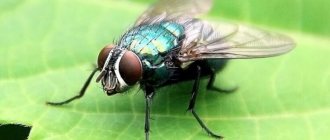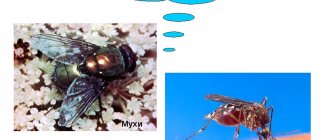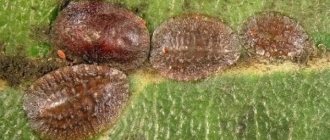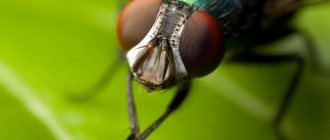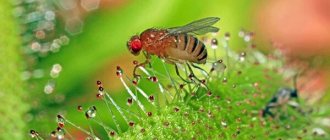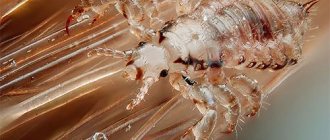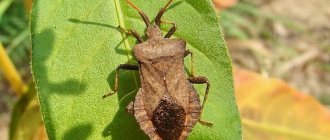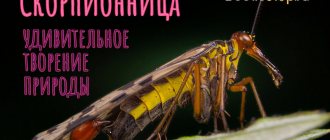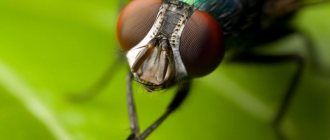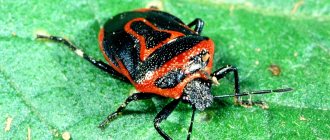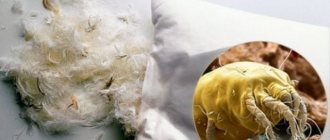The green fly belongs to a large family of blow flies - about 900 species, grouped into 23 genera. Other names: carrion, calliphorid, sarcophagus, meat. Distributed throughout Russia, lives in the warm season. It brings tangible benefits to nature, but harms humans and animals. The green fly is one of the largest representatives of the genus and has an attractive color.
Benefits and harms
The carrion fly plays an extremely important role in nature - it participates in the decomposition of corpses.
However, due to this feature, contact with pathogens is dangerous for humans. Harm:
- The green fly carries dangerous bacterial and viral infections and helminth eggs. The most serious disease is leprosy, the most common is intestinal infection. They enter the human body through food.
- Females lay eggs in deep wounds on the body of humans and animals; the larvae make numerous passages and go through a full development cycle. Their presence brings pain and discomfort.
- Green fly larvae, if accidentally ingested, provoke the development of myiases. Eggs, when they enter the stomach, in most cases die, but with weak immunity or problems with digestion, they penetrate the bloodstream, spread throughout the body, or develop in the intestines. With intestinal myiases, they are subsequently released with vomit and feces. Localization in the eyes is dangerous due to temporary or partial loss of vision; the worm is removed surgically. Penetration of maggots into the brain is dangerous.
- Getting into meat and fish during salting and cooking, they significantly spoil the quality of the product and appearance. The products are not to be consumed.
Benefit:
- During the First World War, doctors noticed one feature - the larvae of carrion flies ate rotting tissue and prevented the spread of infection. The substance they secrete to liquefy food is a powerful antibiotic. This feature is now used in medicine, in the case of difficult-to-heal wounds that cannot be treated with antibiotics. Maggots are raised under sterile conditions.
- Green fly larvae are used as food for birds, fish, and amphibians. Store in the refrigerator to prevent pupation.
- There are two types of green fly maggots. The first smooth ones are exclusively scavengers. The latter, covered with hairs, are predators. They appear a few days later and feed on smooth maggots. The development cycle of the green carrion fly has been well studied, so worms are often used to determine the exact time of death of an animal or person in forensic science.
The green fly enters the house through open windows and doors, and in the absence of favorable conditions, it immediately tries to find a way out. If it finds rotting food, meat, fish, it begins active life.
Prevention
Of course, it is always easier to prevent a problem than to fix it. Therefore, it is necessary to maintain basic sanitary and hygienic conditions:
- dispose of household waste in the house in a timely manner;
- do not leave uncovered food on the table;
- place a mosquito net on the windows;
- Clean pet pens regularly;
- examine animals for wounds to avoid infection with green fly larvae;
- treat manure heaps with biothermal agents;
- promptly dispose of the corpses of dead animals, as well as pests such as rats, moles and others;
- Disinfect latrines with insecticides.
Tansy essential oil repels flies, causing paralysis of their limbs. Bouquets of these flowers, hung in a livestock room or standing in a vase in an apartment, will help get rid of annoying flies for a long time.
Life cycle of a fly, reproduction, its eggs
Flies are insects whose development is characterized by complete transformation, that is, in their life cycle they go through several stages: egg, larva, pupa and adult insect.
Warm summer days are the most optimal time for flies to develop, and the entire life cycle can be completed in a period of 7 to 10 days.
The female lays white eggs, approximately 1.2 mm in length, in small batches in manure or other nutritious moist medium. In total, an adult female fly can lay 100 to 150 eggs at a time. The eggs develop for 1-2 days, after which they enter the larval stage.
Fly larvae: where they live and what they eat
In the initial stage, the fly larva is a white, translucent worm, 3-8 mm long, cylindrical in shape, tapering towards the front. Has no head. The body of the larva is divided into several parts, so-called segments. On the anterior segment there is a mouth opening with special retractable hooks. Legless larvae hatch from eggs in warm weather over a period of 8 to 20 hours and immediately begin to feed and develop in the environment where the eggs were laid. Adult larvae are creamy, shiny, 9 to 12 mm long.
The larvae go through three stages of development, or instars. At this time, spiracles gradually form - openings that lead to the respiratory organs (trachea). The larvae molt three times. At the end of the third stage, the larva turns into a prepupa, which prefers dry places. The body of the larva decreases, becomes thicker, and looks like a barrel. With the last molt, the larva pupates, and does not shed the shell, but uses it to construct the pupal cover.
An adult fly and its pupa, characteristics of the female and male
The pupae of the fly are dark brown, up to 8 mm long. This stage is the resting stage. Under the strong cover of the pupa, a mysterious transformation of a sluggish worm into an adult insect - an imago - takes place in a few days. The wings of a newborn fly are light and soft. In a few hours they will straighten out, become stronger, the chitinous cover will darken, and the fly will be ready for its first flight.
An adult housefly is 6-8 mm long, females are usually larger than males. The fly's body is divided into three parts: the head, thorax and abdomen and is covered with numerous hairs that serve as organs of touch or hearing. The color is gray, there are four narrow black longitudinal stripes on the chest. The abdomen is gray or yellowish. Large compound eyes of a reddish color are located on the anterior segment of the head. These crystal-like eyes are made up of multiple hexagonal lenses and allow the fly to see in all directions. Flies distinguish colors, as well as ultraviolet radiation, invisible to the human eye. But in the dark, flies become helpless, so they are active only during daylight hours.
The fly also has three simple small eyes that can look straight up. In females the distance between the eyes is greater than in males. The fly has black antennae on its head, which serve as olfactory organs. Flies use only the front pair of wings; the hind ones are not developed and are used to maintain stability in flight. It is these rear halteres that produce such a familiar and many unpleasant buzzing sound. At the same time, flies are able to perform complex acrobatic stunts, as well as take off and land without accelerating.
The most common varieties
Gray
It has a large body 10–14 mm in length, with red eyes on its white-yellow head.
The head is divided in half by a black stripe; on the chest there are light stripes located longitudinally. The segmented abdomen of the gray blowfly has an oblong shape, the legs are very densely covered with short hairs.
Blue
The body reaches a length of 10–16 mm, has a blue color with a faint light coating.
The head is yellowish-red, shimmering with a golden sheen.
There are dark whiskers on the cheeks.
The breast is black with a bluish tint.
On the back are faint longitudinal black stripes.
Distributed in all forest regions of Russia.
Green
The body size is 5–10 mm in length.
The body color is green with a metallic sheen.
The abdomen has a faint coating of light shades.
The wings are transparent, the tentacles are yellowish, and the legs are black.
This species is very thermophilic and is found in central Russia only in hot summers.
It mainly lives in semi-desert, desert and steppe areas.
Internal structure
How a fly breathes, can it think, does it have memory, and other questions are often of interest to the average person who has encountered pests more than once.
Reproductive system
The internal genital organs are located in the abdomen and consist of testes in males, eggs in females, accessory glands, and ducts. The shape of the external appendages differs in different species of Diptera. The structure of special “grabs” in males is the only clear sign of difference in the genus. At one time, a female housefly lays from 70 to 150 eggs, depending on the species. Among blowflies (corpse flies) there are viviparous species. They produce maggots in the same large quantities.
Digestive system
The abdomen contains most of the digestive organs - the intestines, crop, Malpighian vessels, excretory tubules. There is no digestive organ as such; food is digested from the outside and enters the crop in a ready-made form. Before absorbing food, the fly initially secretes a secretion, which digests the food.
Other organs, systems
The fly's brain is represented by many nerve plexuses located in different parts of the body. Animals do not have such a complex system as humans. The brain plays a major role in coordinating the behavior of the insect, but a completely different organ is responsible for reflexes - the reflex arc. The tiny brain consists of hundreds of thousands of neurons and, despite the apparent simplicity of its structure, allows flies to perform incredible tricks.
The circulatory system is represented by the aorta, pterygoid muscle, dorsal vessel, and heart. However, the heart of a fly has an extremely simple structure and does not perform the same functions as in humans and animals. The fly's blood is yellowish or colorless. Its main function is the transfer of nutritional components. Does not participate in oxygen saturation of organs, does not contain red blood cells.
The respiratory system is represented by many tracheas throughout the body. Opens outwards with the help of spiracles. The trachea branches into numerous capillaries and has a complex structure. They deliver oxygen directly to various organs and tissues. 10 pairs of spiracles are developed, 2 pairs on the chest, the rest on the abdomen.
Treatment
Many diseases carried by blowflies have specific treatments. Special vaccines have been developed for many. And yet, the main disease transmitted by blowflies is myiasis, the treatment of which we will describe in detail.
Location of the larvae
Since myiasis can be both internal and external, their treatment is different. If the skin is damaged, it is necessary to wait for the larva to mature, after which it moves outward and can be easily removed from the wound using tweezers. To speed up the progress of the larva, you can use various oils: vegetable, camphor, vaseline or those that you have at home. The oils prevent the access of oxygen, thereby causing the larva to move outward. After the larva has been removed, the wound must be treated with an antiseptic and a sterile compress with a disinfectant applied; in case of significant damage, external or systemic antibiotics can be prescribed. And in no case should you try to remove the larva before it approaches the exit, this can lead to its rupture and suppuration of the wound. If internal organs or intestines are damaged, antiparasitic drugs are used; if it gets into the stomach, it is washed out.
Types of hoverflies
The most common types of hoverflies that can be found in our gardens are useful, and only the onion one is an undoubted pest. Below are examples of the most common flies of this family:
- Onion, in Latin "Delia antique", has a size of up to a centimeter in length. The eggs laid in the axils of the leaves hatch into larvae that damage the bulbs, causing them to rot.
- Aquatic hoverflies, or "Eristalis", feed near stagnant water in small natural pools and marshes. The proboscis on their body, like a diver's breathing tube, helps them breathe under the surface of the water.
- The common hoverfly is a flower fly that reaches twelve millimeters in length. Its larva can eat up to two hundred aphids per day. The common hoverfly is an excellent pollinator. The camera captured her on clover
- The wasp fly is most similar to a wasp, hence its name. Its larvae feed mainly on rotten wood, and the adult grows up to eighteen millimeters in length.
- The hoverfly is a little smaller, only one and a half centimeters long, has a darker color and, as its name suggests, resembles a bee.
What is myiasis?
When a fly lands on a person, it lays offspring. It is especially attracted to purulent discharge, although egg deposition also occurs in a healthy organ. Once in the body, the larvae infect blood vessels, soft tissues, even bones. Myiases cause extensive suppuration, bleeding and gangrenous lesions in humans. The creation of channels by parasites in tissues and movement along them cause severe, cutting pain. The disease is more severe in weak people and children. There were cases of death on the 4th day of illness. In an effort to leave the body, the larvae completely destroy the skin.
Reproduction
Males attract females by singing. And the further south the species lives, the louder the male sings. It has even been suggested that the insects use this to scare away predators. The massive chattering of males in the jungle deafens even a person. Predators with their keen hearing have it even worse.
After meeting the male, the fertilized female goes to lay eggs, and the male dies. The female will live a little longer: until she lays several hundred eggs. These insects lay eggs in cuts on the bark of young shoots and leaf axils. The female cuts the bark with her powerful forepaws. Trees usually tolerate bark cuts well, but the leaves die. If there are a lot of cicadas, they can kill the foliage on the trees.
After completion of the clutch, the female dies. The larvae emerge from the eggs after 1.5-2.5 months and fall to the ground. The remaining stages of development, until reaching the surface, the larva will spend underground, feeding on plant roots.
Another difference from flies is the absence of a pupal stage. The nymph that appears on the surface climbs onto a vertical surface to a height of about a meter and freezes. After a short time, the outer cover of the nymph bursts and an adult is born.
Traditional methods
A favorite means of dealing with buzzing and annoying dipterans is an ordinary fly swatter or its harsh analogue - newspaper rolled up in several layers. However, other techniques are common among people to help get rid of annoying insects.
Fly tape
Velcro tape is not the most aesthetically pleasing, but very effective tool. It is sold in any hardware store and has an affordable price. All you have to do is buy it in the right quantity and hang it in crowded places.
The principle of operation is extremely simple: the aroma of the tape attracts the fly, it flies to it to feast on it or lay eggs. It lands on a surface lubricated with a special substance and sticks with its paws. Lack of food or sticking of the respiratory organs leads to the death of the insect.
Pros:
- low cost;
- efficiency;
Minuses:
- the need to watch the dangling fly corpses;
- may cause hair to be pulled out and snags on clothing; In large spaces it will not be possible to get by with Velcro alone.
Vacuum cleaner
Velcro tape comprehensively solves the problem with several dozen flies. But what to do when there are hundreds of them? This is a task for a powerful vacuum cleaner. Arm yourself with the device and treat those places where the greatest accumulation is: windows, window sills, cracks, etc.
Among the disadvantages of this method:
- inconvenience - the vacuum cleaner is heavy and not the most mobile, with it you will not be able to penetrate into secluded places where dipterans are hiding;
- high cost - not every home has a vacuum cleaner, and buying it only to fight flies is not the most sensible and rational decision.
Important! After treating the premises, the device bag must be immediately cleaned and washed so that insects do not have time to leave eggs in it.
Plants
An effective and environmentally friendly tool for combating buzzing dipterans is repellent plants or eater plants. The first include geranium, wormwood, walnut or tansy leaves, field daisies, as well as tomato tops - flies really don’t like their smell. The second one is the Venus flytrap. This is an amazing fly catching plant. Just place it in areas of greatest congestion and the problem will resolve itself.
Natural poisons
Some products that people actively use in cooking turn out to be destructive for flies. Therefore, they can be used in the fight against annoying dipterans and not worry about your own health.
What natural ingredients do insects hate?
- Ground black pepper. It is usually combined with something sweet - honey, jam or glucose syrup.
- Carnation. The spice kills flies - just spread it in crowded areas and after a couple of hours you will see that the home space is free.
- Garlic. It must be cleaned and crushed, scattered where dipterans fly.
As you can see, these are common foods that everyone has in their refrigerator.
Struggle
Controlling blowflies is not difficult and, if basic hygiene rules are followed, may not be necessary at all. You just have to follow the basic rules:
- Do not create a landfill near your home, throwing meat and fish waste there.
- When animals or birds die or are slaughtered, it is imperative to bury their remains under a layer of soil and not allow them to decompose in the open air.
- In the summer, install nets on the windows to prevent blow flies and other insects from entering the premises. This especially applies to people living on the lower floors of apartment buildings or in low-rise buildings.
- Hanging sticky traps can also significantly reduce blowfly numbers.
- A room heavily infested with flies can be treated with some insecticidal agent, for example, the popular Dichlorvos.
Hymenoptera
Orders of insects with complete transformation cannot be imagined without the social representatives Hymenoptera. First of all, these are honey bees and ants. They live in large groups, within which responsibilities are clearly distributed. Thus, a bee family consists of a queen (queen), male drones and numerous workers.
A similar picture is observed in anthills. These insects are real hard workers. By building their homes, they mix the soil, increase its porosity and enrich it with organic matter. Ants are also considered unsurpassed “strongmen”. These unique insects are capable of lifting approximately 25 times their own weight. This is possible due to the extreme contraction force of their muscles.
general characteristics
Diptera insects belong to the family of bloodsuckers (Hippoboscidae), which parasitize warm-blooded animals. Males and females feed only on the blood of their victims. The main “hosts” of this type of bloodsucker are elk, deer, roe deer and other cattle. Flies are often found on wild boars, foxes, bears, as well as dogs, sheep, and goats. Forest birds can also be affected by parasites. When the number of insects is large, they are capable of attacking humans. However, feeding on his blood, the deer fly is not able to complete the reproductive cycle and give birth to offspring, since there is no full range of conditions favorable for this.
The number of individuals in a population directly depends on the presence of deer and elk in a certain area. A representative of the family Hippoboscidae has several names:
- deer bloodsucker is a scientifically used term;
- moose fly;
- moose tick;
- moose louse.
This variety of names is due to the fact that the moose fly is often confused with a tick or louse, although it has nothing to do with these parasites. The external similarity is due to the fact that, when it gets on the body of a warm-blooded animal, the bloodsucker fly sheds its wings. She burrows into the fur and, having bitten through the skin, begins to feed on the blood of her victim.
moose fly
Forest parasites, unlike their other blood-sucking counterparts, are small in size. The body length of the fly ranges from 3 to 3.5 mm. The light brown, flattened, shiny, dense leathery cover reliably protects the bloodsucker from damage. It is able to withstand high pressure and as a result, the fly is difficult to crush. The flattened head with thick antennae located in the deep frontal depressions is directed forward. The moose fly has fairly large eyes, made up of almost 3 thousand facets. They are located on the lateral surfaces of the head. In addition, the parasite has 3 simple eyes.
The piercing-sucking mouthparts are similar to the proboscis of the autumn burner fly. Well-developed and strong legs with thickened hips extend from the flattened chest. The limbs are equipped with asymmetrical prehensile claws. The flat fly has flat transparent wings, the length of which is in the range of 5.5-6 mm. Despite the impressive size of the organs for movement, the flat fly flies poorly and over short distances. Basically, it waits for its prey sitting on the branches of trees, bushes or in the grass. Finding itself on the body of an elk or other animal, the fly breaks off its wings, burrows deep into the fur and begins to bite its “owner” to begin feeding.
Reproduction of moose fly
The ability to reproduce occurs 2-3 weeks after the start of intensive food absorption. Insects that parasitize animals live in pairs. Approximately 19 days after mating, the female “gives birth” to a large prepupa, the size of which reaches 3-4 mm. It develops from an egg and pupa in the elastic abdomen of an elk fly, which can almost double in size during gestation and feeding. After a few hours, the “newborn” is covered with a dense protective shell and falls to the ground. This process occurs during October-March. With the onset of spring, the puppet-bearing forest fly dies, freeing the animals from its presence. At the end of summer (in August), young individuals of winged parasites emerge from the developed pupae.
Under favorable conditions, a female moose fly can produce from 20 to 30 puparia during its entire life cycle, which lasts on average about 6 months. Once on the ground or in the snow, they are quite often eaten by tits, which live in the winter near the deer roost. Animals suffer greatly from the presence of blood-sucking parasites on their bodies. They lead to emaciation, loss of appetite, sleep deprivation and stunted growth in juveniles and adults.
People also get it from bloodsuckers. In the photo, enlarged many times, the moose fly appears “in all its glory.” The insect can be carefully examined to accurately determine its presence on the body of an animal or person.
The distribution range of the moose fly is quite wide. They can be found almost everywhere, but the largest number of pests are found in the following areas:
- European part of Russia;
- Siberia;
- Primorsky Krai;
- northern China;
- countries of the Scandinavian Peninsula;
- North America.
moose fly
The moose fly is mainly attracted to large objects - cloven-hoofed forest animals and large livestock. With a significant increase in the number of insects themselves, they begin to mercilessly attack humans.
Stages of development
The green fly goes through the following stages in its development:
- Egg – 8-25 hours.
- Larva (maggot) – 10±3 days.
- Pupa 3-4 days.
- Adult – 45 days.
Carrion birds quickly find open wounds, dead birds, animals and lay eggs there on the very first day. But they can also be deposited in the damp soil of flowerpots, on rotten fruits and vegetables. The eggs look like white sticks 1 mm long. Development time depends on temperature and humidity.
After a day, small larvae (a little more than 1 mm) appear from them. They develop on a favorable basis - kitchen waste, feces, animal corpses. They have 1 mouth opening plus 2 respiratory openings. There is a black hook in the mouth with which they move.
The larvae constantly secrete juice through this hook, as if from a syringe, under pressure. Under the influence of fermented juice, the tissues quickly dissolve, forming a corpse broth on which the insect feeds. The larvae grow quickly, become thicker, larger, moving to pupation after 7-14 days, choosing warm, dry places.
The pupal stage (puparia) lasts 3 days. After hatching, the adults are ready to reproduce. Each female is capable of laying 100-150 pieces per day, repeating the process every 2 days. During its short life, 1 individual is capable of reproducing up to 700 eggs (6-8 clutches).
Some types of carrion flies can lay up to 2000 pieces in 1.5 months. During one warm period, several generations appear. In warm, indoor areas, insects can breed year-round. They overwinter in any phase except eggs.
What does a fly look like?
Everyone probably knows what this insect looks like, but it’s still worth looking at the presented photos of various flies.
The length of its body ranges from a millimeter level to two cm. The hairy body of the fly has two wings with membranes, a fairly voluminous head and a belly with three pairs of legs.
The mouth is designed like a proboscis that sucks in liquid food. The fly's legs have fairly developed sharp segments and sticky pads that allow it to stay upside down on any surface.
The insect's eyes are designed in a particularly unique way; they contain thousands of hexagonal crystals, which allows the fly to simultaneously see what is happening from absolutely any direction (even the background), that is, it has a circular field of vision. Whiskers are capable of detecting and recognizing many different scents.
Lepidoptera
Insects with complete transformation, examples of which we will now consider, are among the most beautiful representatives of the animal world. Their scientific name is associated with the structure of the wings, which are covered with scales. But everyone is accustomed to calling them butterflies, which in Orthodox translation means “old woman, grandmother.” This is due to the ancient belief that these insects are inhabited by the souls of the dead.
The salivary glands of butterfly caterpillars secrete a special substance from which threads are formed. From these, insects weave protective shells - cocoons or attach pupae to various objects. The threads of silkworms, which can reach 2 km in length, are used to produce natural fabrics.
What sundews look like
These are perennial plants with tuberous thickened roots. Sundews are found on almost all types of soil:
The flowers of these plants are inconspicuous, and the leaves have long, thin hairs. At the tips of the hairs, small droplets of sweet liquid are released, similar to fallen dew. Hence the common name “dewdew”.
The plant's sweet syrup attracts flies and male mosquitoes, which land on the leaves to feed. As soon as the fly touches the hairs, it will stick to the leaf. The syrup is not only sweet, but also viscous. The plant begins to slowly curl its leaf around the fly. After complete folding, the leaf remains in this position until the plant has completely digested the prey.
Several species of sundews are common in Russia, including the type species.
Sundew rotundifolia
A perennial flower that eats flies. The type species that gave its name to the entire genus of sundews. Distributed throughout the Eurasian continent. Prefers swamps, can grow on peat bogs and damp sands.
The round-leaved sundew can safely be called a long-liver - it lives for several decades. But due to poor nutrition, the sundew grows very slowly and does not grow large.
The leaves grow from a basal rosette and are located on the ground. On small round leaf plates there are glandular hairs 4-5 mm long. These hairs secrete droplets of liquid similar to dew.
The round-leaved sundew feeds not only on flies. When an insect touches a sensitive hair, the leaf folds and the hairs dig into the cover of the invertebrate.
Eating insects occurs with the help of those very droplets of liquid, which are actually a digestive enzyme.
English sundew
A perennial plant, common not only in Eurasia, but also in North America. In some regions of Russia it is included in the Red Book.
This is another fly-eating flower. Unlike the round-leaved sundew, the English sundew's diet is based on flying invertebrates, including dragonflies. The leaves of the English sundew are directed upward. The length of the leaf blade is 1.5-3 cm. The width is 5 cm. The leaves are covered with red glandular hairs. When catching a fly, the English sundew leaf wraps itself around the insect. You can see what a flower eating a fly in the middle of the process looks like in the photo below.
Venus flytrap
This native of the North American continent is often grown at home as an ornamental plant.
The Latin name of the flower, muscipula, translates as “mousetrap.” It is believed that this was a mistake by the botanist who described the plant. But there is no confirmation of this hypothesis. The name "Venus" is given in honor of the goddess of love.
It is a herbaceous plant with 4-7 leaves that grow from a rosette. The flower stem is bulbous. The length of the leaves is 4-7 cm and depends on the time of year. Longer leaves grow after flowering.
The leaves of the flycatcher resemble flowers. They are oval shaped and red in color. But this is only a device for attracting invertebrates.
English sundew and Venus flytrap
The name “flytrap” is also not true, just like “mousetrap”. The Venus flytrap is not a flower that catches flies. These dipterans are occasional prey, occupying only 5% of the diet of the carnivorous plant. The bulk of the diet of this plant consists of invertebrates crawling on the ground. A third of them are ants.
Even the flytrap leaf looks like a trap. It is almost smooth inside and has sensitive hairs along the edges. If the hairs are disturbed at least 2 times with an interval of no more than 20 seconds, the sheet will begin to close the edges.
The digestion process takes on average 10 days. Then the leaf opens, “throws out” the empty chitinous shell and awaits the next prey. During the life of one trap leaf, an average of 3 insects fall into it.
The habitat of the Venus flytrap in its homeland is swamps. This flower can easily live on a windowsill or in the garden if it has a sufficiently moist earthen ball. Drying out is harmful for the flycatcher.
Modern methods
Of course, life does not stand still. Methods of combating dangerous insects are constantly being improved and modernized. Below are more effective alternatives to home remedies.
Trap lamps
A more effective and functional analogue of the usual adhesive tape. They are mounted on the wall, have a stylish design and easily fit into the interior. The principle of operation is simple: the fly flies towards the light, but sticks to a trap placed in front of an ultraviolet emitter. In order for the insects to continue to die, it is necessary to periodically change the paper.
Insecticidal lamps
The principle of operation is the same here. The only difference is that dipterans do not stick to paper, but practically end up in the “electric chair”. It's all about the electrical grid through which current is passed. The fly flies towards the light, but eventually dies from the discharge.
Important! A person can take hold of this lattice. For him, the discharge discharge is safe.
Electric fly swatters
This device is ideal for those who like to be on the move. In appearance it resembles a badminton racket, but the plastic base is replaced with a metal one. The fly is shocked by the electric charge.
Electric fumigators
The principle of the device is extremely simple: after connecting to the network, the device begins to evaporate the composition of the tablet, which is toxic to insects. It is effective, but has a significant disadvantage - it is not suitable for large rooms. The optimal area of premises is up to 12 square meters.
Fly traps
A fly trap is an effective and visual tool. You can make such a mechanism yourself, but stores also offer a wide range of parasite traps. The simplest homemade trap is made from a plastic bottle:
- Rinse the empty, unwanted plastic bottle with water and dry.
- Cut off the top of the bottle using scissors. Try to cut as evenly as possible - this affects the quality of the trap.
- Turn the cut top over and insert it into the bottle.
- Secure the result. Connect the two parts with tape or a stapler.
- Prepare the syrup. To do this, boil one glass of water in a saucepan and add half a glass of sugar. When the sugar dissolves, cool the resulting syrup.
- Carefully pour the syrup into the bottle. Additionally, lubricate the edges of the trap with it. You can also add other baits to the syrup: small pieces of fruit, such as apples. Meat that has begun to rot is also perfect. Fill the trap so that there is a little less than a centimeter left to the neck of the bottle.
- Place the trap in a warm and open place. A well-heated window sill is best.
Purchased traps come in a variety of shapes and prices. The cheapest ones cost about 300 rubles, while prices for the most expensive ones can be above 8,000 rubles.
spring-cleaning
This method involves eliminating the source of attraction for insects. In the kitchen, you need to wash the refrigerator, cabinet and other surfaces, clear the table, and wash the dishes.
To prevent pests from entering your apartment, store stale food in a separate sealed container, cover the trash can with food waste, and constantly treat the trash can with disinfectants.
Chemicals
Chemicals on the market are represented by the following main groups:
- sticky tapes. One of the most popular, simple and effective methods. Its main disadvantage is the deterioration of the aesthetics of housing. Velcro is a strip lubricated with a sticky substance with a sweet smell. The principle of operation is simple - the fly, attracted by the aroma, sits on the tape and sticks. After this, from lack of food (and sometimes due to sealing of the respiratory organs) it dies.
- fumigator. The operating principle of this device is to evaporate a toxic (only for flies, of course) composition of a tablet introduced into the body. Connects to the mains. The main disadvantage of the device is that it is not suitable for large rooms. It is best to use it in rooms up to 12 m2,
- aerosol. Sprays and aerosols are more suitable for protecting the area from parasite invasion. However, they are also suitable for preventing the appearance of flies and exterminating insects that have already appeared in the apartment. It is necessary to spray the spray over the area of the room. Flies cannot tolerate the active ingredients and suffocate or fly away. Nothing bad will happen to a person from the aerosol, however, such drugs should be used with caution for those suffering from asthma or allergic reactions,
- gel with poison. Gels with poison for flies are applied either to a special substrate, which is sold along with the product, or to the surfaces themselves with which flies most often come into contact. Insects are attracted by the aroma of the gel, but upon contact with it they receive a lethal dose of poison and die. As with previous drugs, this poison is absolutely safe for humans, but it is better to hide the gel pads from children.
A cool period has come and the flies have become uncomfortable living outside. You open the door a little and migrants instantly take over the house. If in the summer it was somehow tolerable, then by autumn it became unbearable. In practice, we still use adhesive tapes, but, you must admit, this is not a very effective method, and such a device does not look aesthetically pleasing in the middle of the hall on a chandelier, and every now and then someone sticks to it. Fumigators that plug into an outlet scare me, especially with a small child. And aerosols are not a solution at all. At that moment, when the flies had already completely overcome, we decided to look for a remedy that would suit us all, but really did not suit these insects. And you know, we found it. The gel [Mukhoyar Fly Gel] is applied to a substrate (we press it onto jar lids) and hidden, for example, behind a vase on a cabinet, on a window sill behind a flower pot, on a kitchen unit. So they don't spoil the view. And the child will not get into the product. Moreover, flies do not stick to the gel. The gel has no odor. It does not release hazardous substances into the air, so it is absolutely safe to use it even in the presence of children. But, of course, you shouldn’t touch it with your hands.
Using homemade traps
If for some reason a person cannot buy special sticky traps for flies, then you can make insect bait yourself using improvised means. First, make syrup (50-60 grams of sugar per 100 milliliters of water with the addition of lemon juice). Next, cut pieces of paper to the required length, spread with the prepared solution and leave to dry. A hole is made in the top of the trap for a loop.
After the syrup has dried, the strips are hung in places where flies are most concentrated. Another option for a homemade trap is to use a milk solution with the same sugar concentration. The liquid is simply poured into a jar, after which the containers are placed around the perimeter of the apartment.
Here's another way to make homemade fly traps.
Mechanical methods
Mechanical methods are simply killing flies with a fly swatter, newspaper, slipper or anything else that comes to hand. This method can only be effective if two or three parasites appear that have flown to you completely by accident. If there are about a dozen flies and they keep multiplying, then a fly swatter is not enough.
Professional pest control
If there are too many flies, you should consider the services of professionals. Fortunately, pest control has now become quite accessible. For an average of 1,500 rubles, professional services will rid your apartment of flies. As a rule, cold and hot fog generators are used for this, which destroys all parasites in the apartment. After this, the services can additionally treat the house to prevent the subsequent penetration of insects into your home.
When choosing a pest control service, rely on independent reviews. If possible, ask your neighbors and friends.
Where do fruit flies come from in an apartment?
Maintaining an almost sterile cleanliness in the home is the main guarantee that fruit flies will not appear in the apartment. But only on condition that it is possible to maintain the same sterility throughout the entire house. Fruit flies will take up residence in the garbage chute, which is removed once a day. Or a neighbor who keeps a bowl of fruit on the table and doesn’t really care about their freshness. At the first opportunity, fruit flies will show themselves in the apartment.
There are several ways where fruit flies come from:
- “come” to the house with purchased fruits;
- insects or eggs can be carried into the house on shoes or clothing;
- they fly in from the garbage chute, if there is one in the house;
- enter from a neighboring apartment through a ventilation hole;
- They have been living indoors for a long time somewhere in a flower pot.
Flies of this species can live and breed in flower pots, since there is always rotting organic matter in the soil. And this means warmth and food. Feeding plants with tea leaves, popular among amateur gardeners, means another feast for fruit flies.
It’s enough to not remove food leftovers from pets in time, and small flies are already hovering over them. A spilled drop of tea, milk, or juice will serve as food for these insects. A trash can that is not taken out on time is a paradise for breeding.
If there is a neighbor in the house who is seriously interested in terrariums or aquariums, he breeds fruit flies for his fish or reptiles.
Habitat
Emerald lucilia is common in many countries of the world with warm summer climates. Its peak activity occurs during the hottest time of the year. It is in the heat that decay processes most strongly emit an odor, which is a bait for insects. In addition to carrion, green-bellied flies are also attracted to other sources of unpleasant stench:
- feces;
- rotting fruits and berries;
- plants with a rotting smell;
- food waste landfills;
- fresh and salted fish;
- meat.
Are dung flies harmful?
Dung flies do not cause much harm to humans. Despite the fact that they carry pathogenic bacteria, they practically do not fly into human housing, so there is no need to be afraid of infection. For most animals, these insects also pose no threat, since they are not parasites and do not bite.
However, it happens that during active reproduction the number of flies increases very quickly and they begin to bother livestock, flying into the eyes and getting into the ears. In this case, you should think about ways to reduce the number of annoying insects.
If leaf miner larvae are found in gardens, which harm plants by making tunnels for movement in them, gardeners must immediately take the necessary measures to destroy them.
Short description
Flies belong to the order Diptera. Unlike other insects, they have only one pair of membranous wings. The movable head is quite large in size, and the oral apparatus is a special proboscis. The purpose of the hind wings is to regulate balance.
The special skeleton of these pests and strong muscles allow them to develop high speed in flight and stay in the air for quite a long time. In addition to natural flies, synanthropic flies, which exist near humans, are considered widespread. Among them, the most famous are, for example, true flies, blue, green and gray blowflies and hoverflies.
Features of house flies
These pests are prominent representatives of synanthropic insects - those whose life is connected with human habitation. People constantly struggle with this type of fly. There are many quite effective means for this, but it is not yet possible to get rid of insects once and for all. Unlike bedbugs and cockroaches, flies are exclusively diurnal.
What are blowflies?
These insects got their name because they breed on animal corpses. According to the color of the back, there are gray, green and blue blowflies. The appearance of gray pests resembles ordinary house flies. Adult females do not lay eggs. They immediately hatch the larvae, having previously selected a suitable place for them, which can be the decomposing body of an animal, fruit rot or manure.
Green (carrion) flies have a beautiful appearance, despite the fact that they are partial to carrion and various impurities. They feed on rotting organic matter, where females lay eggs - up to 200 at a time. The resulting larvae leave the carrion and hide in the soil to pupate. This stage lasts 1-2 weeks. After this time, an adult fly emerges from the surface.
What are hover flies?
However, not all flies are pests. Hover flies are very reminiscent of wasps - both in external characteristics and in their behavior. In summer, they can most often be seen near Asteraceae or umbelliferous plants. The body of the insect is covered with black and yellow stripes, and on the semicircular head there are large dark brown eyes. The diet of adults consists of flower nectar.
The female lays approximately 100–180 eggs at a time, so 2–4 generations of these insects can develop during the season.
Hover flies are beneficial insects because they destroy aphids, which cause irreparable damage to trees in the garden.
Some gardeners try to create all the conditions for flies of this species to breed in their areas. To do this, they specially plant umbrella plants, such as carrots, dill or parsley.
What kind of disease is this
Infection of humans by insect larvae - dermatomyasis is of two types:
superficial - the larvae parasitize on the surface of the skin and do not go beyond the epidermis.
It can be caused by gadfly larvae; a person can become infected through contact with these animals. The larvae are very mobile, quickly move under the skin, gnawing passages up to 30 cm. The parasite can stay in the human body for up to 2-3 months. Subcutaneous myiasis caused by these parasites is characterized by excruciating itching; the larvae's passages resemble long scratches.
The popular name for the disease is “creeping disease.” Treatment for myiasis is mechanical removal of the parasite.
deep - parasites penetrate under the skin, are located in the deep layers of the epidermis, sometimes this type of lesion becomes tissue
Insects are able to penetrate even healthy skin, and not only as a result of a bite. Sometimes infection occurs even through contact with infected foliage. Many species of flies that can infect humans live in Africa, North and South America, but there are species that are found in Russia, for example, Wohlfahrtia vigil and Wohlfahrtia opaca (Wohlfart fly), various types of sheep and cow gadflies. They are also available in Europe, Pakistan, and North America.
Infestation occurs seasonally, from June to September, with the larvae hatching within 24 hours. Boils appear at the sites where parasites invade. The maturation of the larvae ends on days 12-14, after which they leave the host’s body and pupate.
tissue - the lesion affects soft tissue, this form can occur when flies lay eggs on the edges of wounds, ulcers, wounds, and other damage to the surface of the body.
Cases of the development of larvae in wounds are classified as a separate subtype of the disease - wound. Its danger increases due to the possibility of a secondary infection; in addition, symptoms of fever and severe bleeding from the affected areas develop.
Some species of flies that live in North and South America are capable of laying up to 3,000 eggs even in a small wound, which, when hatched, begin to destroy human tissue and cause serious, deep damage. Insects sense the presence of possible places to lay eggs; even a tiny scratch can attract a female.
Some types of insects are able to penetrate not only damaged skin, but also healthy skin. Symptoms of this are the occurrence of ulcers, boils with severe itching.
Symptoms of insect penetration under the skin are the appearance of ulcers, boils with severe itching
Contact with cattle may cause infection with bovine botfly larvae. At the same time, it is not necessary to touch and stroke the animals - there are cases when a female insect lays eggs on human hair.
The first stage of infection is almost asymptomatic, then slight swelling may appear as the larva moves. A fistula forms at the site where the parasite molts; the usual location is the upper shoulder girdle, head. The larva remains in the fistula until maturity, then leaves the host’s body through the hole and pupates.
The disease is manifested by severe allergic reactions and signs of toxic poisoning of the body (nausea, vomiting, even memory loss). In addition, symptoms occur:
- elevated temperature
- short-term muscle pain
- There may be pain in the heart.
Getting larvae into the eyes is especially dangerous. Insect parasitism in this case can be accompanied by severe pain, swelling of the temporal region, and can lead to decreased and even loss of vision.
Cases of oral myiasis have been observed, when the surface of the oral cavity is affected.
In addition, there have been cases of parasites penetrating the spinal cord and brain. In this case, the mechanism itself has not yet been determined.
intestinal
Such infection of the human intestines (intestinal myiasis) can occur when eating unwashed vegetables or food that has been left uncovered for a long time.
Some types of flies live in the salty environment of cheese or salted fish and can be eaten.
Severe nausea, vomiting, pain in the stomach - these are the main symptoms of infection by fly larvae. If left untreated, colitis (inflammation of the mucous membrane of the large intestine) may develop. The human intestine may contain housefly, meatfly, and carrion larvae.
Lifestyle
Wohlfart's fly is a synanthropic organism. But she lives only in the air. Active during the hottest time of the day. Flies into houses by accident. Adult sexually mature individuals feed on:
- nectar of flowers, giving preference to umbelliferous species;
- honeydew;
- wound exudate;
- slurry.
The larvae of this species pose a medical danger.
Larvae
The Wohlfarth fly is a viviparous species. During her life, she can lay 100-200 larvae. Unlike blowfly maggots, which can even be useful in cleaning wounds, the Wohlfarth maggot feeds on living tissue.
Life cycle of the Wohlfarth fly
In order not to die itself, the fly tries to get rid of the young as quickly as possible. The female lays live larvae in wounds and abrasions. The newly born offspring immediately delves into the soft tissues, gnawing their passages and causing myiases. In sheep, the female lays eggs on the genitals or open wounds. Like the gadfly, the Wohlfarth fly can lay larvae, spraying them into the eyes on the fly.
During the feeding process, the larvae are able to gnaw out large areas of soft tissue. Such activity of maggots leads to closed suppuration and then to necrosis.
The person's eyes, ears, nose and mouth are usually affected. Most often, the female lays eggs on a sleeping person. But it can also attack someone who is awake.
Appearance of the larva
At the time of laying, the length of the larva is 1 mm. The body shape is elongated, cone-shaped. White color. At the head end there are powerful oral hooks and two tubercles. On the back there is a spiracle. During the growth process, only the size of the larva changes, which can reach 1.5 cm at the last stage of development.
The larvae emerge from the host's body at the end of August and immediately pupate for the winter. Adults appear in spring.
Symptoms of invasion
The severity of symptoms largely depends on the number of parasites; the more there are, the more acute the disease. The larvae infect the mucous membranes, penetrate deep into the tissues, and lead to significant damage to the oral cavity.
Main symptoms:
- itching caused by moving around the oral cavity;
- swelling of the mucous membranes, hyperemia;
- open wounds, ulcers, mucosal disorders;
- with significant damage to the gums - inability to chew normally, pain;
- swelling in the nasal passages, difficulty breathing, rhinitis and nasal congestion often develop;
- intoxication of the body caused by decay products, fatigue, malaise;
- allergic reactions to toxins.
With severe damage, a noticeable rise in temperature and a feverish state are possible. Many experience lip deformation and difficulty speaking due to tongue disorders. Pus is released from the oral cavity, and there is an unpleasant smell of rotting.
Features of the insect
Wohlfarth's fly is quite often referred to as tungsten fly. However, the last name is incorrect. The insect is named after Wohlfarth, the doctor who first (in 1770) described this very dangerous creature. The body structure of the Wohlfarth fly is similar to that of an ordinary housefly, but everything is presented in enlarged sizes.
- An individual of this species is a large insect of a light gray color, the body size of which can be up to 14 mm in length.
- On the mesonotum, 3 dark longitudinal stripes are clearly visible; black spots are also present on the sides of the ovoid abdomen.
- On the silvery head there are compound eyes, painted in dark red, and it also has black antennae and a licking proboscis.
- The insect has well-developed transparent wings. The entire body and limbs are covered with stiff hairs.
- Individuals of different sexes differ in the structure of their genital organs. Males also have a wider forehead (photo of a Wohlfarth fly is presented below).
